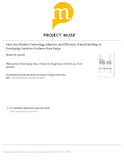| dc.description.abstract | Low efficiency is a problem in most developing agriculture, and is one of the reasons for food insecurity. This paper provides information on smallholder production efficiency in one of the developing Sub-Saharan Countries: Kenya. It applies Data Envelopment Analysis (DEA) to farmlevel seasonal panel data. The estimated indexes indicate high levels of inefficiency between farm sizes, seasons, and adopters and non-adopters of ‗modern‘ farming technologies. A comparison of various farming practices shows that use of modern inputs and livestock-based capital could significantly improve farmers‘ performance. Tobit estimations show that the major factors influencing performance are the level of education, gender, market access and off-farm capital. Thus, policies aimed at improving education, rural infrastructure as well as assuring farmers of income through improved livelihood opportunities, and therefore reduced perceived uncertainty, could improve farm-level efficiency. The findings also provide support for prioritizing issues of farm production associated with women in policymaking | en_US |

